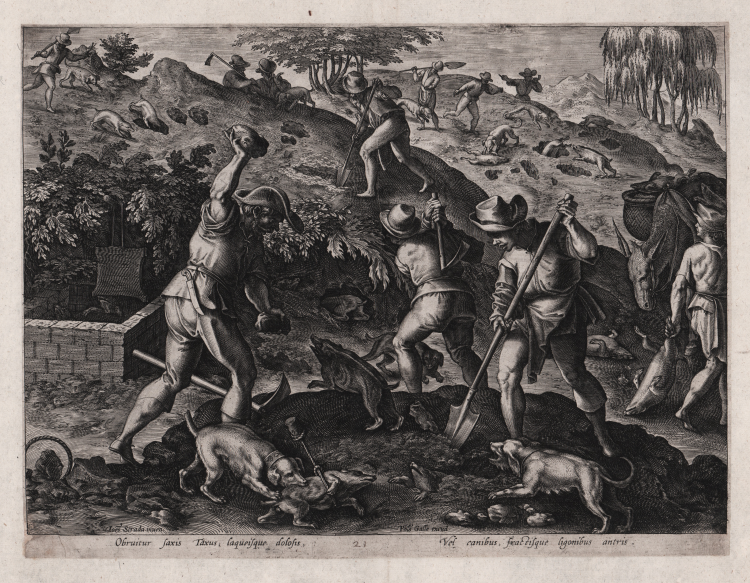




| Reference: | S45943 |
| Author | Anton II Wierix |
| Year: | 1578 |
| Measures: | 280 x 215 mm |



| Reference: | S45943 |
| Author | Anton II Wierix |
| Year: | 1578 |
| Measures: | 280 x 215 mm |
Badger hunt: in the foreground, a huntsman uses a shovel to unearth the badgers from their burrows, while two hunters attack the badgers with rocks and an axe, dogs aid the hunt; to far right, a man loads a donkey with the kill; beyond, the hunt extends over two slopes.
Lettered within the image: 'Ioes Strada. inven. / Phls Galle excud.' Lettered in lower left, on rock: "An. W". Lettered below the image: 'Obruitur saxis Taxus, laqueisque dolosis, / Vel canibus, fractisque ligonibus antris.'
Engraving, circa 1578. Example of the rare first state, before the number.
From the "Venationes Ferarum, Avium, Piscium", after Jan van der Straet called Stradano or Stradanus, published by Philip Galle.
Once back in Antwerp, after a long trip to Italy, Stradano met Philip Galle, former pupil of Hieronumus Cock, who had recentely devouted himself to the art of printing. They planned together the realization of hunting subjects, inspired by the tapestry of the Villa in Poggio a Caiano. At the beginning, Galle realized a series of engravings without numbers, to which a second edition followed, with title page and 44 numbered plates. The sudden fame of his work convinced the printer to go on with his cooperation with Stradano, who realized new drawings with uncommon and exotic hunting subjects.
The new series was published first separately, then together with the first edition, forming a wide series of 104 plates, named Venationes Ferarum, Avium, Piscium, Pugnae. This work can be dated between 1578 (on the front page) and 1596. As for the tapestry of the Villa in Poggio a Caiano, the work is divided in three wide categories: terrestrial, air and water animals. At the beginning the hunting scenes have been engraved by Philip Galle himself, who then hired other members of his family and other assistants, among which Adriaen and Jan Collaert, Theodor and Cornelis Galle and Carolus de Mallery.
Magnificent work, printed on contemporary laid paper, trimmed to the platemark, in good condition. Laid down, on the four corners, on antique mounting.
Bibliografia
New Hollstein (Dutch & Flemish) / The New Hollstein: Dutch and Flemish etchings, engravings and woodcuts 1450-1700 (441.I); Baroni Vannucci 1997 / Jan van der Straet, detto Giovanni Stradano, flandrus pictor et inventor (693.53).
Anton II Wierix (Anversa 1552 circa - 1604)
|
Anton II Wierix, together with his brothers Johannes and Hieronymus, was active in Antwerp until his death in 1604. The Wierix family, sometimes also referred to as Wiericx, was a Flemish family of printmaking and engraving artists, active in Antwerp and Brussels in the late 16th and early 17th centuries. They were all very productive, having produced a total of 2,333 engravings, the largest number done by Johannes. Members of the Wierix family were known for their attention to detail and superb technique.
|
Anton II Wierix (Anversa 1552 circa - 1604)
|
Anton II Wierix, together with his brothers Johannes and Hieronymus, was active in Antwerp until his death in 1604. The Wierix family, sometimes also referred to as Wiericx, was a Flemish family of printmaking and engraving artists, active in Antwerp and Brussels in the late 16th and early 17th centuries. They were all very productive, having produced a total of 2,333 engravings, the largest number done by Johannes. Members of the Wierix family were known for their attention to detail and superb technique.
|